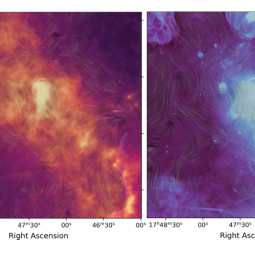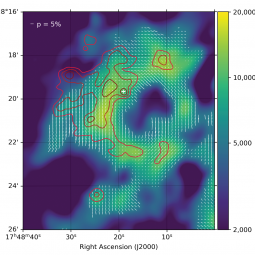by Natalie Butterfield
The role that magnetism plays in the central engines of galaxies remains an open question. Our own Galactic Center (GC) exhibits phenomena and conditions that are rare and extreme within the Milky Way, and hence offers the closest look at the physics of these unique regions of spiral galaxies. One of the most striking features of the GC is the existence of the so-called “nonthermal filaments” (NTFs; Yusef-Zadeh, Morris and Chance, 1984), large, filamentary structures of radio synchrotron emission that highlight the GC’s magnetic field in regions of hot gas. Most of these structures are perpendicular to the orientation of the galactic plane, indicating that the field in the hot gas within the GC is poloidal.
Molecular gas within a few hundred parsecs (pc) of the GC, known as the Central Molecular Zone (CMZ), also exhibits extreme characteristics that are typically only found in intense star-forming regions with high magnetic field strengths (≥100 μ G) and molecular densities (10 3 –10 6 cm -3 ). These gas and dust particles in the CMZ tend to coalesce into a large-scale structure with a radial distance 50–100 pc from the supermassive black hole, Sgr A*. As these clouds traverse around Sgr A*, they transport mass and energy in their orbital motion and could be interacting with and influencing the magnetic fields in this region of the galaxy. Two outstanding questions are of interest. First, how does the magnetic field in the cooler, denser, dust-dominated phases of the GC relate to the poloidal field present in the ionized phase? Second, does such a connection relate to the physical mechanism responsible for the formation of NTFs? Measurement of polarized emission from magnetically-aligned dust grains using SOFIA/HAWC+ provides a mechanism for studying the magnetic fields in the cool dust of the CMZ.
The FIREPLACE (Far-InfraRed Polarimetric Large Area CMZ Exploration) Legacy Survey is designed to address these questions. The FIREPLACE survey measures the polarization at 214 µm across the entire CMZ at unprecedented resolution (<20”; 0.7 pc). This program is complementary to the SALSA Legacy program in which magnetic fields in external galaxies are measured and characterized (Lopez-Rodriguez+2022). A pilot program (0.5 degrees around the Sgr B complex) for the FIREPLACE survey was undertaken in Fall 2021 and provides the first insight into these questions.
The initial magnetic field vectors from the FIREPLACE pilot program are shown as line integral contours (Leedom & Cabral 1994) in Figure 1 above, superposed on both Herschel/SPIRE 250 µm thermal dust emission (Molinari+2011) and on 1 GHz emission from MeerKAT (Heywood+2022), which is dominated by synchrotron emission at this low frequency. The galactic plane is oriented at a slight NW-SE diagonal in Figure 1, and a few NTFs can be seen in the lower right of the MeerKAT image (right panel of figure). The field traced by the HAWC+ polarization measurements is complex. There are regions where the field structure follows the far-infrared morphology, those where the field is parallel to the plane, and those where it is perpendicular.
A quantitative analysis reveals a bimodal distribution of magnetic field directions in which there are enhancements in the distribution of field directions parallel and perpendicular to the galactic plane (Butterfield+2022). The parallel field vectors are more evident at higher far-infrared intensities (presumably corresponding to higher density regions) and likely result from the shearing of the field by the gravitational motion of the cloud clumps in their orbits around the CMZ. At lower densities, the field direction distribution has an increased contribution in the direction perpendicular to the plane, which matches the direction of the field traced by the NTFs. The idea of a complex field in the dust component of the GC has been posited (Chuss+2003), but FIREPLACE has an increase of coverage of more than two orders of magnitude from previous ground-based measurements at comparable angular resolution, enabling the statistical testing of this hypothesis.
In addition to studies of the large-scale field, the FIREPLACE pilot program has enabled the investigation of individual clouds in the CMZ region. M0.8-0.2, shown both in Figures 1 and 2 above, has a structure in which the magnetic field is predominantly azimuthal with respect to a ring-like morphology. We interpret this structure to be an expanding shell in which the ambient field is stretched and compressed. This may be a result of feedback — we identify a candidate source (shown as a white “+” in Figure 2) that may be responsible.
The magnetic field directions inferred for M0.8-0.2 are most clear in Figure 2, where the azimuthal orientation of the magnetic field can be readily seen. Using the Davis-Chandreshkar-Fermi Technique, we have estimated field strengths of 200-400 microGauss across the source. The dust associated with M0.8-0.2 is cool (T~15K; Molinari+2011) and no significant X-ray and very faint 1 GHz synchrotron emission is seen.
The pilot study for FIREPLACE provides a proof-of-concept for making large polarimetric maps with SOFIA. Once completed, FIREPLACE will provide data across the entirety of the CMZ, an area corresponding to 1.5 degrees in galactic longitude (approximately 250 pc at the GC distance, 8 kpc). This will provide tens of thousands of Nyquist-sampled measurements with an angular resolution of 20”, covering all of the major structures of the CMZ.

